
Lantana is a genus of about 150 species of perennial flowering plants in the verbena family, Verbenaceae. They are native to tropical regions of the Americas and Africa but exist as an introduced species in numerous areas, especially in the Australian-Pacific region, South and Northeastern part of India. The genus includes both herbaceous plants and shrubs growing to 0.5–2 m (1.6–6.6 ft) tall. Their common names are shrub verbenas or lantanas. The generic name originated in Late Latin, where it refers to the unrelated Viburnum lantana.

The Pterophoridae or plume moths are a family of Lepidoptera with unusually modified wings. Though they belong to the Apoditrysia like the larger moths and the butterflies, unlike these they are tiny and were formerly included among the assemblage called "microlepidoptera".
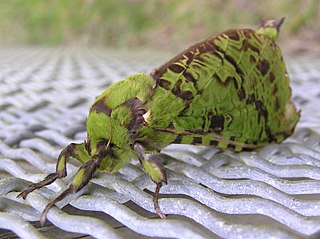
Aenetus is a genus of moths of the family Hepialidae. There are 24 described species found in Indonesia, New Guinea, New Caledonia, Australia and New Zealand. Most species have green or blue forewings and reddish hindwings, but some are predominantly brown or white. The larvae feed in the trunks of living trees, burrowing horizontally into the trunk, then vertically down.

Lantana camara is a species of flowering plant within the verbena family (Verbenaceae), native to the American tropics. It is a very adaptable species, which can inhabit a wide variety of ecosystems; once it has been introduced into a habitat it spreads rapidly; between 45ºN and 45ºS and more than 1,400 metres in altitude.

Hyles livornica, the striped hawk-moth, is a moth of the family Sphingidae.

Crocidosema is a genus of tortrix moths belonging to the tribe Eucosmini of subfamily Olethreutinae. They are found mostly in the Southern Hemisphere, being especially common in the Neotropics. But some occur elsewhere, such as on the Hawaiian Islands.

Lantanophaga pusillidactyla, the lantana plume moth, is a moth of the family Pterophoridae. It is native to the southern United States, Mexico, the Caribbean, and South America. It was introduced to Australia accidentally in 1936 and is now found from Sydney to Cairns along the coast. It has also been introduced to Hawaii in 1902, Pohnpei in 1948, and Palau in 1960 for biological control. It has since been recorded from Yap in 1987–1988 and is now distributed on all islands of the Mariana and Caroline Islands where the host plant is found, except Aguijan.

Strymon bazochii, the lantana scrub-hairstreak or smaller lantana butterfly, is a butterfly in the family Lycaenidae. It is found from Paraguay north through Central America, the West Indies and Mexico to southern Texas. It was introduced to Hawaii in 1902 to control Lantana species, in which it has proven unsuccessful.
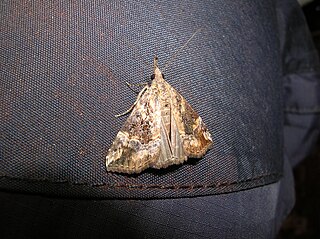
Hypena laceratalis, the lantana defoliator, is a moth of the family Erebidae. It was first described by Francis Walker in 1859. It is native to Africa to Yemen, India and Myanmar but was deliberately introduced to Australia via Hawaii in 1965 to control the weed Lantana camara.
Diastema tigris, the lantana moth or lantana control moth, is a moth of the family Noctuidae. The species was first described by Achille Guenée in 1852. It is endemic to the US states of Florida and Texas, but has been introduced in Zambia, Australia, Micronesia, Fiji, Hawaii, Ghana, St. Helena, Tanzania, Uganda and Mauritius. as biological control of Lantana camara.
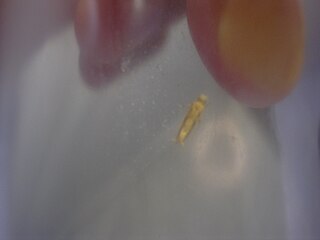
Erechthias minuscula, the erechthias clothes moth, is a moth of the family Tineidae. It was first described by Lord Walsingham in 1897. It is widespread and has been recorded from Africa, Sri Lanka, Java, Australia, the Caroline Islands, Fiji, Samoa, the Marquesas, the West Indies, Hawaii and Florida.

Anstenoptilia marmarodactyla is a moth of the family Pterophoridae. It is native to California and Arizona, south through Mexico to Costa Rica. It is an introduced species in Hawaii.

Crocidosema lantana, the lantana flower-cluster moth or lantana tortricid moth, is a moth of the family Tortricidae. It was first described by August Busck in 1910. It is native to Mexico and the southern United States, but was introduced to Hawaii in 1902, Australia in 1914 and the Caroline Islands in 1948 and 1949 to aid in the control of Lantana weeds. It has also been recorded from Yunnan, China and in Sri Lanka.
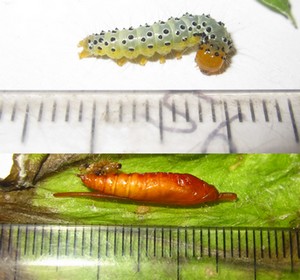
Salbia haemorrhoidalis, the lantana leaftier, is a moth of the family Crambidae. It is native to South America, Central America, the Antilles and the southern United States, but has been introduced in Hawaii in 1956, Queensland in 1958 and Réunion, Mauritius to control Lantana. The species was first described by Achille Guenée in 1854.
Pseudopyrausta acutangulalis is a moth of the family Crambidae described by Pieter Cornelius Tobias Snellen in 1875. It is native to South America, Central America and the Antilles. It has been introduced to Hawaii to control species of the genus Lantana.
Megalorhipida dulcis is a species of moth in the genus Megalorhipida known from Belize, Costa Rica, and Mexico. Its host plants are Lantana urticifolia and Lantana glandulissimus. Moths of this species take flight in November and have a wingspan of about 11 millimetres (0.43 in).
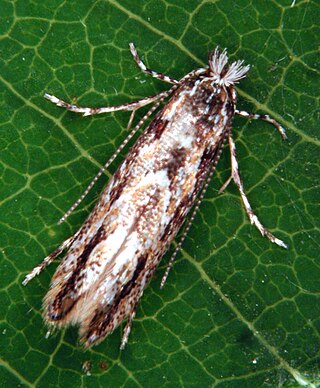
Lithocolletinae is a subfamily of insects in the moth family Gracillariidae. It is distributed worldwide, with most species in temperate regions.

Phoebis agarithe, the large orange sulphur, is a butterfly in the family Pieridae. It is found from Peru north to southern Texas and peninsular Florida. Rare strays can be found up to Colorado, South Dakota, Wisconsin, and New Jersey. The species has also been introduced in Hawaii. The habitat consists of open, tropical lowlands including gardens, pastures, road edges, trails and parks.

Aconophora compressa is a species of insect in the treehopper family, Membracidae. It is known by the common names lantana bug, lantana treehopper, lantana stemsucking treehopper, and lantana sap-sucking bug.
Ectaga garcia is a moth in the family Depressariidae. It was described by Vitor O. Becker in 1994. It is found in Minas Gerais, Brazil. The species was introduced to northern New South Wales to control Lantana camara. However, the species has failed to establish itself in Australia.















